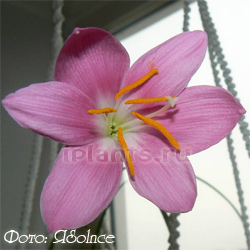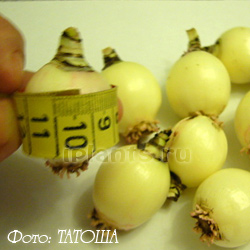Amaryllis family. Homeland - South and Central America. There are about 40 species in nature.
- Zephyrantes large-flowered Zephyrantes grandiflora is a perennial bulbous plant. The bulb is about 5 cm in diameter, rounded, deepened into the substrate completely. Leaves are narrowly belt-shaped, dark green, up to 40 cm long and about 1 cm wide. Flowers are single on a peduncle up to 30 cm long. Perianth funnel-shaped, about 8 cm in diameter, pink with bright orange stamens. Flowering from April to July.



- Zephyrantes white Zephyrantes candida is a perennial bulbous plant. The bulb is small - only about 3-4 cm in diameter, rounded, deepened into the substrate completely. The leaves are narrowly belt-shaped, dark green, up to 30 cm long and about 0.5 cm wide. The flowers are single on a peduncle up to 20 cm long. The perianth is funnel-shaped, about 6 cm in diameter, white on the inside and pinkish on the outside. Flowering from July to October.
- Zephyranthes versicolor - has oblong bulbs, with dark upper scales, 3 cm in diameter. The leaves are linear, about 30 cm., Appear after flowering. Flowers 5-7 cm long, erect, white, with a reddish-green tint on the outside. In classification since 1821, originally from Brazil. Synonyms: Amaryllis versicolor ((Herb.) Spreng.), Habranthus versicolor (Herb.), Hippeastrum versicolor ((Herb.) Baker), Zephyranthes pluricolor (Herter), Zephyranthes versicolor ((Herb.) G.Nicholson).
Caring for Zephirants
Temperature: During the growing season in the range of 23-26 ° C during the day, 15-17 ° C at night. During the rest period they are kept at 12-14 ° C, at least 10 ° C, in dryness.
Lighting: Bright sunny place. In summer, marshmallows are planted in the garden - he is not at all afraid of the bright sun, if taught, gradually removing the shading (mesh, veil).
Watering: Moderate during growing season. The soil should dry well in the top half of the pot. During the dormant period, zephirantes can lose leaves - then the bulbs are kept dry, if the leaves remain, then the plant is occasionally watered.
Fertilizer: Once every two weeks with liquid mineral fertilizer for flowering indoor plants, diluted in the concentration recommended by the manufacturer from the moment new leaves appear until the end of flowering.
Humidity: If the weather is hot and dry in summer, the plant can be sprayed periodically, but usually zephirantes do not need spraying.
Transplant: About once every 3-4 years, during the dormant period. Soil - 1 part of sod, 1 part of sheet earth, 1 part of humus, 1 part of fine gravel (fraction 2-3 mm). Choose a pot that is not too spacious, take into account the height of 2 cm for drainage. It is important that the drain holes are not clogged with expanded clay or earth.
Reproduction: Daughter bulbs that plant several pieces in wide plates. The planted bulbs are watered very little at first and must be shaded in the afternoon. With good care, they will bloom next year.